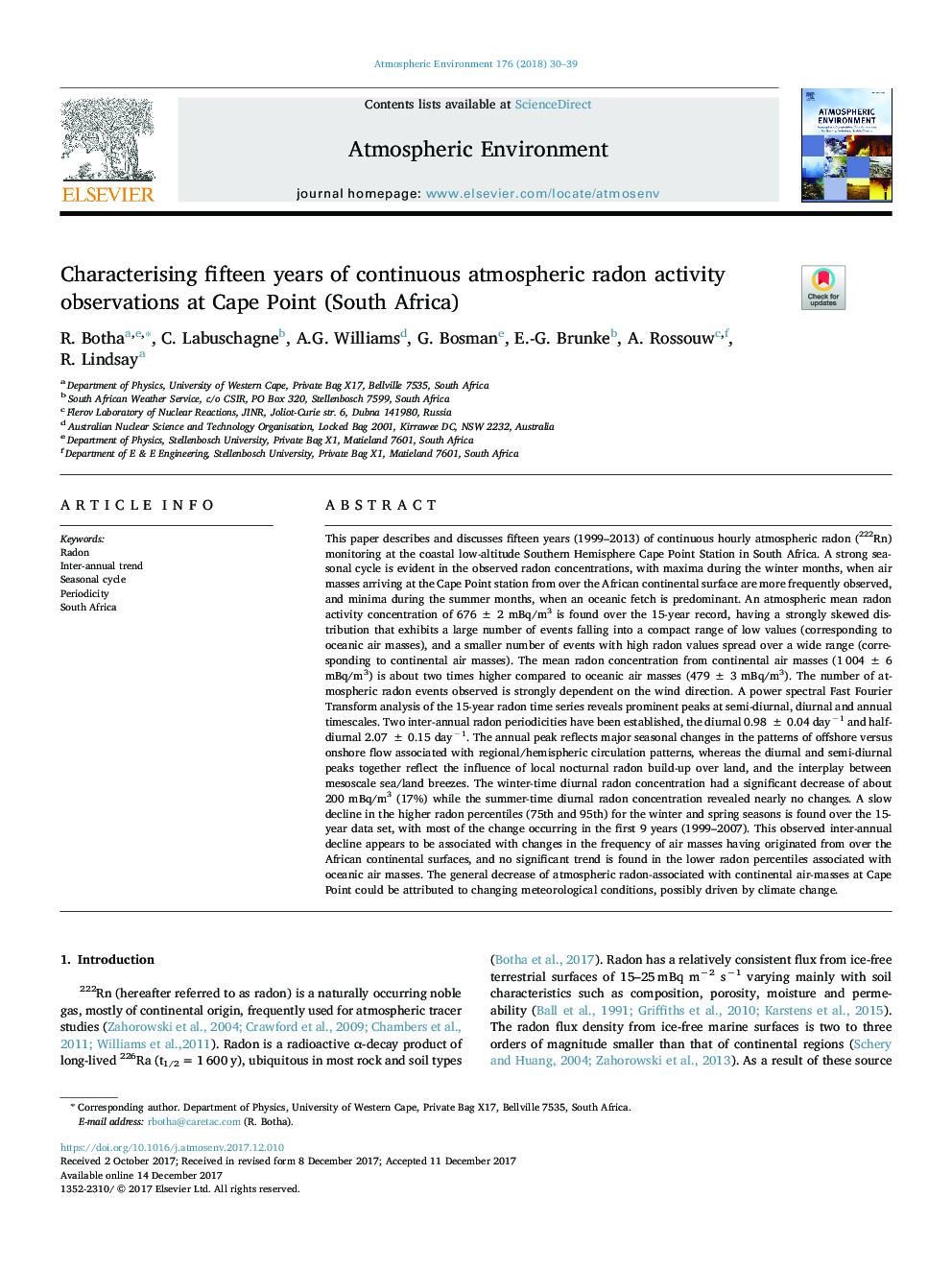| کد مقاله | کد نشریه | سال انتشار | مقاله انگلیسی | نسخه تمام متن |
|---|---|---|---|---|
| 8864112 | 1620298 | 2018 | 10 صفحه PDF | دانلود رایگان |
عنوان انگلیسی مقاله ISI
Characterising fifteen years of continuous atmospheric radon activity observations at Cape Point (South Africa)
ترجمه فارسی عنوان
مشخص کردن پانزده سال مشاهدات فعالیت رادون اتمسفر در جو زمین در کیپ پوینت (آفریقای جنوبی)
دانلود مقاله + سفارش ترجمه
دانلود مقاله ISI انگلیسی
رایگان برای ایرانیان
کلمات کلیدی
رادون، روند بین سالیانه، چرخه فصلی، دوره ای آفریقای جنوبی،
موضوعات مرتبط
مهندسی و علوم پایه
علوم زمین و سیارات
علم هواشناسی
چکیده انگلیسی
This paper describes and discusses fifteen years (1999-2013) of continuous hourly atmospheric radon (222Rn) monitoring at the coastal low-altitude Southern Hemisphere Cape Point Station in South Africa. A strong seasonal cycle is evident in the observed radon concentrations, with maxima during the winter months, when air masses arriving at the Cape Point station from over the African continental surface are more frequently observed, and minima during the summer months, when an oceanic fetch is predominant. An atmospheric mean radon activity concentration of 676â¯Â±â¯2 mBq/m3 is found over the 15-year record, having a strongly skewed distribution that exhibits a large number of events falling into a compact range of low values (corresponding to oceanic air masses), and a smaller number of events with high radon values spread over a wide range (corresponding to continental air masses). The mean radon concentration from continental air masses (1â¯004â¯Â±â¯6 mBq/m3) is about two times higher compared to oceanic air masses (479â¯Â±â¯3 mBq/m3). The number of atmospheric radon events observed is strongly dependent on the wind direction. A power spectral Fast Fourier Transform analysis of the 15-year radon time series reveals prominent peaks at semi-diurnal, diurnal and annual timescales. Two inter-annual radon periodicities have been established, the diurnal 0.98â¯Â±â¯0.04 dayâ1 and half-diurnal 2.07â¯Â±â¯0.15 dayâ1. The annual peak reflects major seasonal changes in the patterns of offshore versus onshore flow associated with regional/hemispheric circulation patterns, whereas the diurnal and semi-diurnal peaks together reflect the influence of local nocturnal radon build-up over land, and the interplay between mesoscale sea/land breezes. The winter-time diurnal radon concentration had a significant decrease of about 200 mBq/m3 (17%) while the summer-time diurnal radon concentration revealed nearly no changes. A slow decline in the higher radon percentiles (75th and 95th) for the winter and spring seasons is found over the 15-year data set, with most of the change occurring in the first 9 years (1999-2007). This observed inter-annual decline appears to be associated with changes in the frequency of air masses having originated from over the African continental surfaces, and no significant trend is found in the lower radon percentiles associated with oceanic air masses. The general decrease of atmospheric radon-associated with continental air-masses at Cape Point could be attributed to changing meteorological conditions, possibly driven by climate change.
ناشر
Database: Elsevier - ScienceDirect (ساینس دایرکت)
Journal: Atmospheric Environment - Volume 176, March 2018, Pages 30-39
Journal: Atmospheric Environment - Volume 176, March 2018, Pages 30-39
نویسندگان
R. Botha, C. Labuschagne, A.G. Williams, G. Bosman, E.-G. Brunke, A. Rossouw, R. Lindsay,
